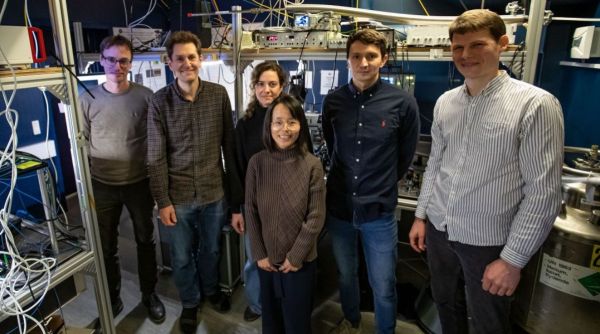In a major breakthrough, researchers from the University of Copenhagen and Ruhr University have discovered how to control two quantum light sources rather than just one. Although a small step of one to two might seem too anticlimactic to qualify as a breakthrough, this new technology could potentially be scaled up to create a universal, error-correcting quantum computer, often called the holy grail of quantum computing.
According to the University of Copenhagen, researchers around the world have been working for years to develop stable quantum light sources to achieve what is known as quantum mechanical entanglement. In the context of photonic quantum computing, entanglement refers to when two light sources can affect each other instantaneously, potentially even over large geographic distances. Entanglement is a concept that is central to the development of an efficient quantum computer.
When two light sources are entangled, it means that if you control one of the light sources, the other is also affected almost immediately. This technology can then be extended to create an entire network of entangled quantum light sources, which can be used to perform “quantum bit operations” just like you do with normal bits in a computer.
The researchers were unable to fabricate two entangled light sources due to their extreme sensitivity to noise. “The problem is largely the ‘charge noise’ of the carriers in the vicinity of the quantum emitter which gives spectral jitter. We overcome this by using ultra-clean materials and applying a low-noise bias voltage across the quantum dot emitter,” Peter Lodahl, co-author of the research paper published in the journal Scienceinformed indianexpress.com via email.
To achieve the feat, the researchers used a nanochip as large as the diameter of a human hair. Over the past five years, the team has developed this nanochip, eventually improving its performance.
“We start with ultra-clean materials grown in a UHV molecular beam epitaxy chamber by our colleagues in Bochum, Germany. After that, we manufacture small chip devices using our dedicated and very well tested etching processes. Finally, we fabricate an electrical contact on the samples and protect the experiment from excessive electrical noise,” Lodahl explained.
According to the researchers, this technology can be adapted to use 20 to 30 entangled quantum light sources that can potentially be used to build a “universal error-correcting quantum computer”, an effort in which tech companies are investing billions of dollars. .
 Part of the research team is represented here. From left to right, Peter Lodahl, Anders Sørensen, Vasiliki Angelopoulou, Ying Wang, Alexey Tiranov, Cornelis van Diepen. Photo: Ola J. Joensen. (Image credit: Niels Bohr Institute)
Part of the research team is represented here. From left to right, Peter Lodahl, Anders Sørensen, Vasiliki Angelopoulou, Ying Wang, Alexey Tiranov, Cornelis van Diepen. Photo: Ola J. Joensen. (Image credit: Niels Bohr Institute)
According to the European Research and Innovation Magazine, the main distinction between a classical computer and a quantum computer is their different sets of rules. Unlike classical computers, quantum computers do not use zeros and ones or “bits”. Instead, they work with “qubits”.
Bits can be thought of as a light switch – it’s on or off, one or zero. Qubits have a special property that allows them to exist in a state where they are both zero and one. This layering will theoretically allow quantum computers to do things that go beyond classical computers.
“I think quantum computers would mainly be used to solve difficult quantum problems. For example, in the context of understanding complex chemical reactions such as in a drug discovery pipeline or for the engineering of new materials. Quantum computers are not very mature yet, and all over the world different qubit platforms are being researched, each with their advantages and disadvantages,” Lodahl said, referring to different quantum technologies.
“Photonics is an increasingly serious competitor, mainly because it seems easier to move to large processors compared to some of the competing approaches. Our work is a key stepping stone to using deterministic single-photon sources for photonic quantum computing,” Lodahl added.
According to the researchers, it is too expensive for a university to build an installation capable of controlling ten, fifteen or more light sources. It is therefore now up to other players, such as private companies and laboratories, to deepen the research work and find applications for the technology.
